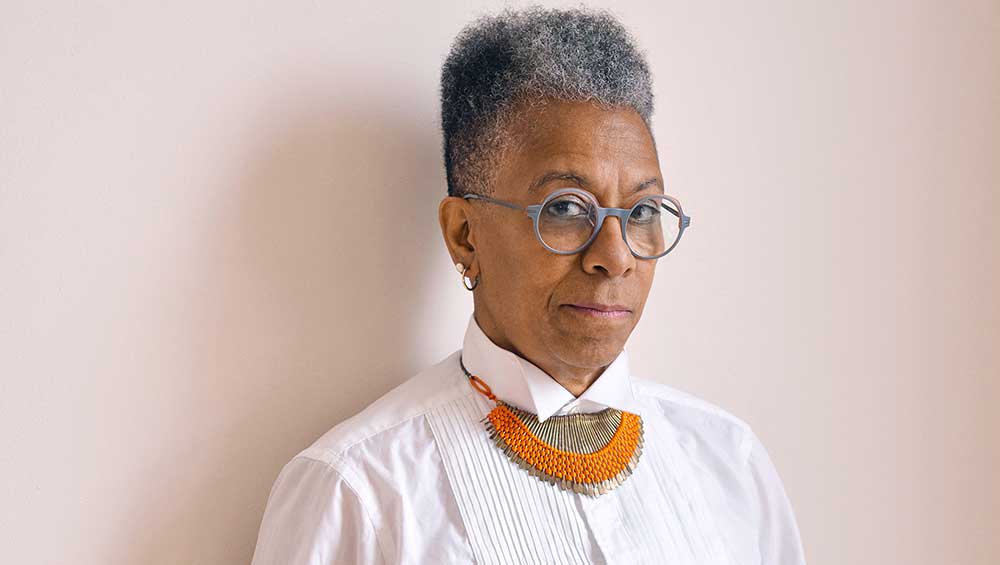
Ingrid Pollard. Photo: Emile Holbar.
by VERONICA SIMPSON
Ingrid Pollard, who was born in 1953 in Guyana, grew up in London and, along with Sonia Boyce, Lubaina Himid and Veronica Ryan, is one of the key figures of the black British art scene that sprang up in the 1980s. She has built a solid body of work during the intervening decades, while teaching, appearing in group shows and receiving fellowships and residency awards. However, she is at last receiving proper recognition, with her first solo show in a major UK gallery, at the MK Gallery in Milton Keynes.
Photography is her medium, and she has pioneered its use within contemporary social practice to question the social and cultural constructs behind race, identity, community and gender. She reveals subtle and not so subtle injustices around these issues through her use of landscape, iconography and gesture. Often embedding herself in communities for long periods of research, she incorporates all manner of digital and analogue technologies, from Victorian photographic processes to film, with images presented on a range of materials including wood, fabric and slate.
-1991.jpg)
Ingrid Pollard, Deny: Imagine: Attack (detail) 1991. Silver gelatine multiple images, 87 x 74cm. © and courtesy of the artist.
This exhibition presents a complete overview of Pollard’s work, in a thematic rather than chronological fashion. One of her most important early works, Deny: Imagine: Attack (1991), in which fragmented images of the body are captioned with ignorant and homophobic remarks, is saved for the final gallery. Here, it is shown alongside one of her most recent works, the tension-inducing Bow Down and Very Low - 123, (2021), which incorporates three kinetic sculptures, two of which appear to be about to inflict violence on the viewer with a baseball bat and a wooden stick, and the third, an assembly of ropes and leather straps, creaking into a folded “bow” – of respect or of fear, who knows? To add further ambiguity, the piece is completed by still images from an archive UK film showing a young black girl who has been chosen as the local May Queen, curtseying, with that gesture halted in freeze-frame.
-2021.jpg)
Ingrid Pollard, Bow Down and Very Low - 123 , (detail), 2021. Kinetic sculptures. Made in collaboration with Oliver Smart, kinetic artist, dimensions variable. Photo © Franklyn Rodgers, 2022. All rights reserved. Courtesy of the artist.
The British pastoral landscape has been an ongoing fascination. The degree to which black people are made to feel “other” when they appear in the countryside, anywhere in the UK, was explored first in the 1980s, with Pastoral Interlude (1987).
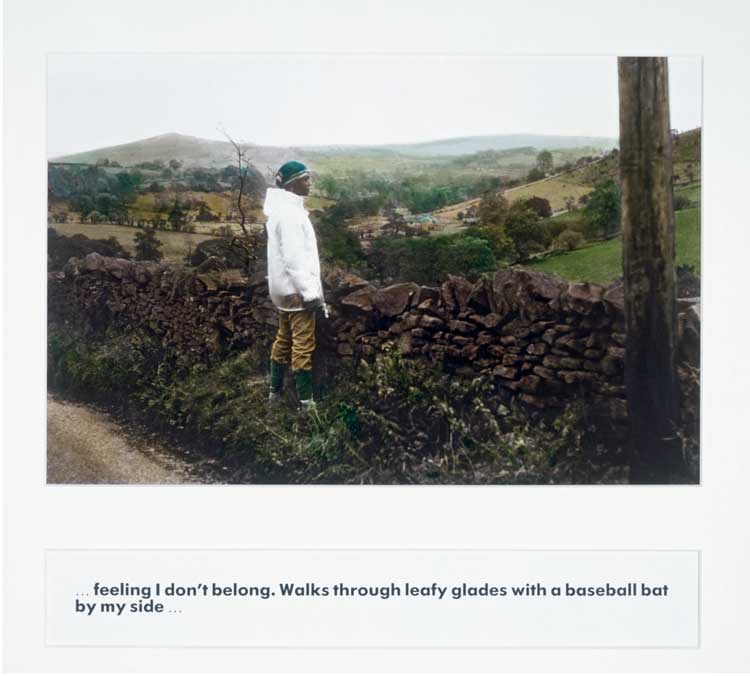
Ingrid Pollard, Pastoral Interlude, 1987. Gelatin silver hand-tinted print, each 25.5 x 38.8cm. © Ingrid Pollard. Victoria and Albert Museum, London.
That series is displayed here, in the same gallery as a newer work, The Valentine Days #1 1891/2017 (2017), which reproduces vintage photographs from the Valentine’s Archive, which were commissioned to showcase Jamaica as a place for tourism but also as lure for speculative development.
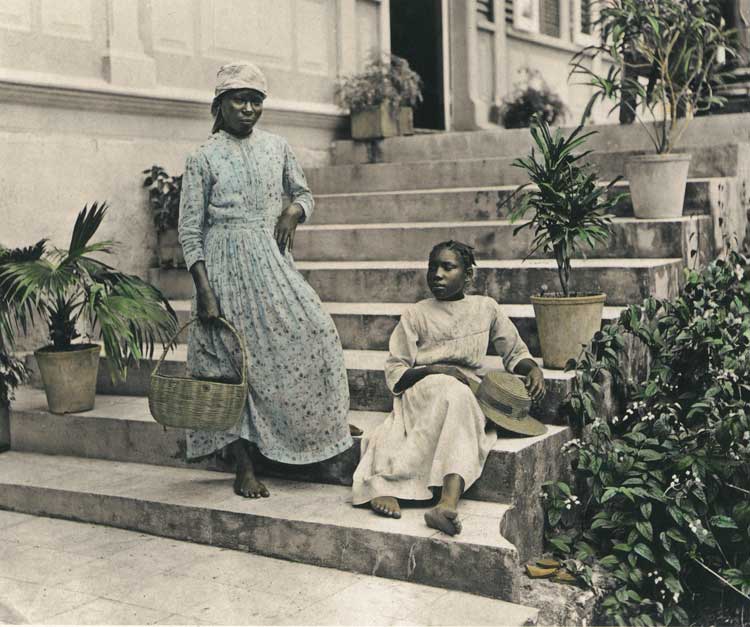
Ingrid Pollard, The Valentine Days #1 , 1891/2017. Digital hand-tinted image, 80 x 64 cm. Commissioned by Autograph, London © and courtesy of Ingrid Pollard / The Caribbean Photo Archive / Autograph, London.
Pollard has taken these black-and-white images and hand-coloured them, drawing attention to the more incidental figures – not the ones lounging in the foreground and clearly staged or posed by the photographer, but the ones quietly going about their business.
As a photographer, Pollard has played an important role in documenting black creativity and presence in 1980s Britain, with portraits of performers, actors and writers, including Alice Walker, Theatre of Black Women, Ellen Kuzwayo, Jackie Kay and Maya Angelou. Several of these portraits appear in the show, along with a range of remarkably intimate portraits she took of fellow artist residents in a former cotton mill in Lancashire and in a Normandy chateau, where Pollard undertook two recent residencies. For the former, she used a pinhole camera, which requires the subjects to stay completely still for 10 seconds, and there is a wonderful quality of surrender in their postures and faces, of acceptance, openness, curiosity; they glow with subdued colour.
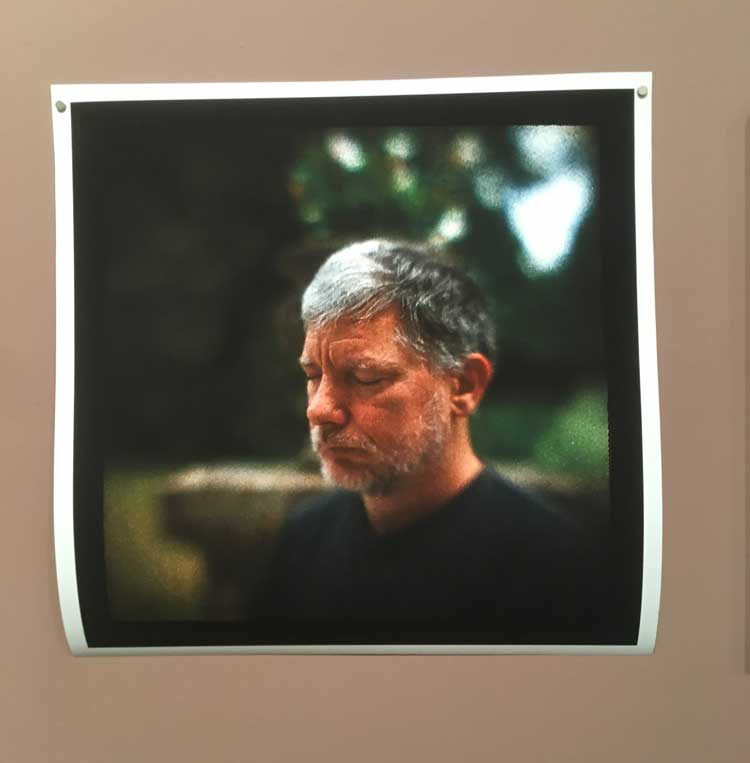
Installation view, Pinhole camera photo, Lancashire and Normandy residency. Photo: Veronica Simpson.
Pollard completed a BA in film and video at the London College of Printing in 1988 and an MA in photographic studies in 1995 at the University of Derby. She was awarded a PhD by publication by Westminster University in 2016. She was involved in seminal group exhibitions of the 1980s, including Black Women: Time Now at the Battersea Arts Centre in 1983, The Thin Black Line at the ICA in 1985, and the latter show’s revised presentation Thin Black Line/s at Tate Britain in 2011. Her work appeared in the Nottingham Contemporary exhibition The Place is Here, which recognised that extraordinary flowering of talent in diversity in 2017. From 2005-07, she curated Tradewinds 2007, an international residency concluding with an exhibition at the Museum of London Docklands. She has appeared in many group shows, including at the Hayward Gallery and the Victoria and Albert Museum, and was in the MK Gallery’s inaugural reopening show, The Lie of the Land, in 2019. In 2016, she received an honorary fellowship of the Royal Photographic Society, and in 2018 became the inaugural Stuart Hall Associate Fellow at the University of Sussex. Her work is held in the collections of the V&A, Cartwright Hall, the Tate, and the Arts Council.
Veronica Simpson: The first room features a film that pairs women rowing on the river with couples doing the tango. What brought those ideas together?
Ingrid Pollard: I used to row, and I was studying tango. I was doing both at the same time. They are very similar. You have to be super-aware – you’re listening with your body. If you go like this [tilts head] in the boat, it makes the boat go like that [indicates the other direction]. You have to cooperate with everybody: you’ve all got to be doing the same thing at the same time. The tango, it’s traditionally not a choreographed dance. It’s not the way it is presented on Strictly. The leader and the follower are doing different dances. The leader is saying, with a gesture, please come this way. And the follower doesn’t have to do that. And they’re slightly out of time. The leader is just before the beat to be able to have that momentum. There are all the technicalities, like the follower’s hips are following the leader’s shoulders. Subtle little things, but you both have to be super-aware of everything. And in rowing you have to do that, talk to each other, that communication. In tango, they’re not staring into each other’s eyes, they don’t really do that. They’re looking to the side – unless you’re totally erotically into your partner. And rowing is something else that you have to be in rhythm with the others in the boat.
Both involve gestures and non-verbal communication - using your body and moving through space. And the second gallery is about how you choose to negotiate space. The horizon line and how you question it. Everything about the African figure in the UK. The works are about England and about black people. Representation or misrepresentation.
-2019.jpg)
Ingrid Pollard, Seventeen of Sixty Eight (detail), 2019. Mixed-media installation, dimensions variable. © and courtesy of the artist.
VS: As Gilane Tawadros [the exhibition curator] said during our tour, you have collected pub signs and stained-glass windows representing different kinds of black figures as they appear in the English landscapes – in pubs, homes, churches even - sometimes ennobled and sometimes really not. She suggested you were doing English Heritage a favour. What about the little room that follows, which features your own wallpaper design, along with a film inspired by your father?
IP: I was doing research in France and Lancashire at the same time. In the chateau, I noticed the toile de jouy wallpaper, which is typically an idealised landscape, with landowners relaxing, drinking and singing, and people working in the background. I combined that with archive photography from a Lancashire cotton mill, including patterns and a figure that comes from the Kumasi fabric traditions of Ghana – there’s an image of a man with the implements he uses to print the fabric, and this image crops up again in the archives of the British Museum. It’s about cotton and labour, and the chateau in question made a lot of money from sugar beet, so it’s about labour and money and patterns.
VS: The film is very moving, with reminiscences, photography and airmail letters from your father about his early experiences in England. I wondered about this rigorous, experimental way in which you explore and use photography, whether you’re showing how that photographic lens is a filter that colours perception, in the same way that you and others might feel, as a person of colour, that the lens of racial ignorance and assumptions can completely colour people’s perception of you?
IP: Yeah. It’s hard to know … to talk about that, because it’s something imposed on you. It doesn’t affect my inner core. I don’t know. Thinking about one aspect of it, whether it’s beauty and landscape, it’s not always about reflection on race. That’s part of living in England, in the same way gendered responses happen, so if you think about how it affects you, it’s a multitude of responses. Intersectionality, as they call it, it’s all happened to us in lots of different ways, and it’s about which one you choose to address. Sometimes, you address them all.
-1992.jpg)
Ingrid Pollard, Self Evident (detail), 1992. Nine colour light boxes, each 50.8 x 50.8 cm and eight silver gelatin prints, each 84.1 x 118.8 cm. © and courtesy of the artist
VS: I wondered if that was why photography had appealed to you.
IP: It happened by accident. It’s never that formal. It’s not a sociological treatise, I’m interested in still images, and I like photography and doing it, I haven’t gone over to film. A lot of photographers do. And younger artists who are photographers, a lot of them are DJs and performers and they write. I just like to concentrate on photography and that vast history of the world as it has been photographed since 1835 and Henry Fox Talbot developed the negative. There is still masses of work to do - and people are doing it now - trying to decolonise the archives.
From the beginning of photography, people have been going out and using their camera to photograph different cultures. The first Thomas Cook holiday photography and anthropologies were all in a 10-year period, so they were all linked, and medical and science … photography has got a bit of a dirty past (gestures to the Valentine series).
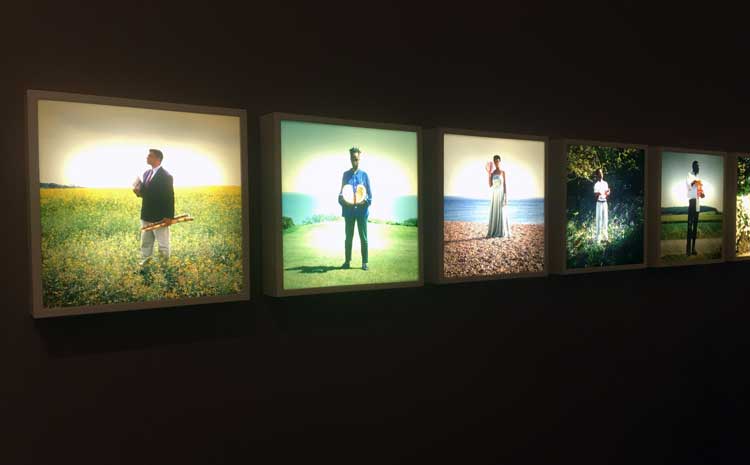
Installation view, Self Evident series. Photo: Veronica Simpson.
I’ve got early photos of Scotland that were commissioned, where you can see Scottish people and archetypes, like Scottie dogs and shepherds on a hill. J Valentine and Co was a major print company, active in the whole of Europe. That particular set of pictures [at her Milton Keynes show], I’ve seen them in two or three museums: as well as being collected by museums as photography, they were sent out as postcards and now they are in archives, the actual photos.
VS: There is the power of these images to establish certain narratives, that’s really interesting. I love the idea of picking out in colour the people whom the photographer might have seen as incidental, but they are absolutely vital.
IP: Or the photographer might never have seen them.
VS: Photography is a way of bearing witness to a certain moment.
IP: I’ve spent hours and hours with a photograph, looking at it, and then thought: “Wow, what’s that, is that a spec of dirt? No, it’s a leg.”
-1995.jpg)
Ingrid Pollard, Contenders (detail), 1995. Gelatine silver prints, colour prints, 3D objects, dimensions variable. © and courtesy of the artist.
VS: It’s that practice of close observation. It had never occurred to me, though it was obvious when you mentioned it during our preview tour, about the work Contenders (1995) – breaking down the poses and accoutrements of male boxers - that boxers have this extraordinary sense of their bodies as a spatial tool, very clear about exactly what they’re making vulnerable, what they’re trying to project.
IP: You know, how they walk up to the ring, with that music playing, with the hoodie on? Which is kind of gorgeous when I see it. I don’t know in terms of women doing that, it’s slightly different. You know when they walk around with a number between rounds. It’s different. When you get female boxers and female cage boxers it’s different, because we’re so used to women being presented like that as objects of beauty. Whereas men, it’s bordering on homo-erotica. It’s very different; other than women presenting as hard men – the “I’m so tough” stance.
-1995.jpg)
Ingrid Pollard, Contenders (detail), 1995. Gelatine silver prints, colour prints, 3D objects, dimensions variable. © and courtesy of the artist.
VS: Contrast that with the pinhole camera images [portraits of her fellow artists in residence in Normandy and Lancashire]. You told us the subjects had to stand still for about 10 seconds. There’s such a lovely quality about each one, they’ve all got their own way of surrendering to that process.
IP: Yeah, they’re giving themselves to me.
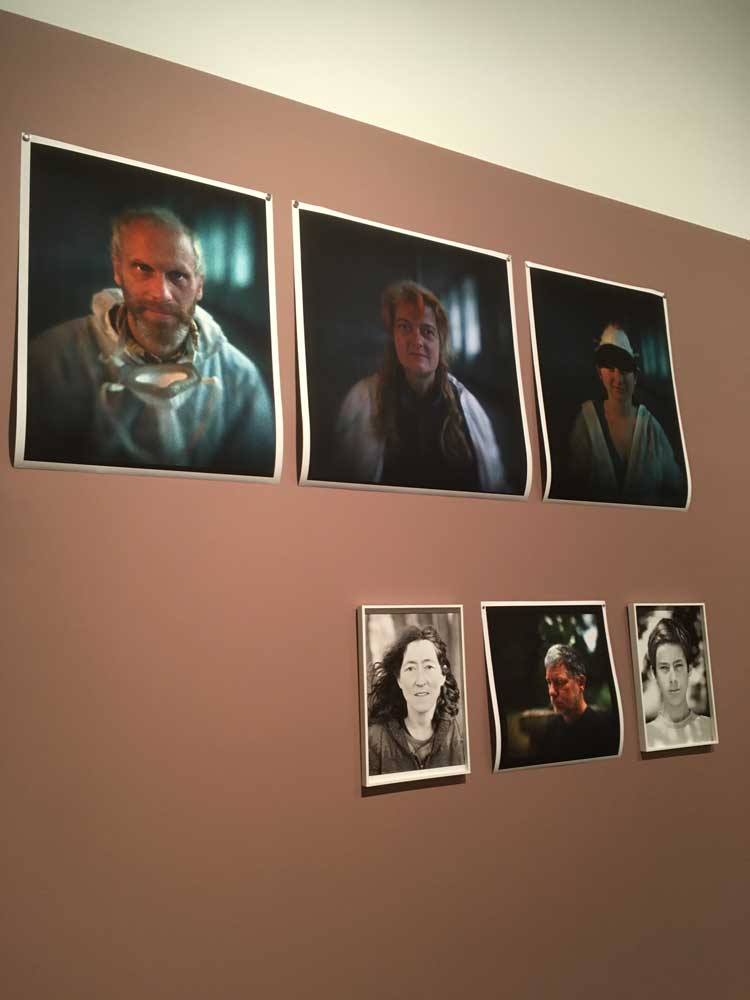
Installation view, Lancashire and Normandy residency portraits. Photo: Veronica Simpson.
VS: It’s so unusual. You don’t normally see that quality of openness or softness of expression.
IP: These are all people I know, all around me. They’re chums.
VS: The kinetic sculptures at the end. That’s one of your newest works?
IP: Yes, I just finished this last year. It’s a collaboration with Oliver Smart [kinetic artist]. I like to collaborate a lot. But sculpture is so far away from photography. Film, painting, performance, even that’s all closer. The work is about power dynamics and that gesture of bowing – I’ve always looked at that gesture, the little girl on the film. Her curtsey, she’s obviously been practicing - she’s only seven or eight - it’s very elaborate. Did you ever see that picture of Theresa May curtseying to Prince William? It was all elbows and joints and knees, and she was wearing leopard-print shoes, and it was a very deep one. And Prince William looked really embarrassed … We looked at lots and lots of films of bowing and the movement and image of it, because Oliver works in puppetry as well as kinetics. He’s always invested in the body, he’s not like a fabricator. He’s about how the body moves.
The sculptures embody a gesture, a type of movement or repetition. The baseball bat when it goes very softly, then very intense, there’s a sense of violence.
VS: Bowing is also about humility.
IP: Yes, but she’s been made the May queen? When you watch the film, you ask yourself: why is she bowing? They should be bowing to her.
• Ingrid Pollard: Carbon Slowly Turning is at the MK Gallery, Milton Keynes, until 29 May.